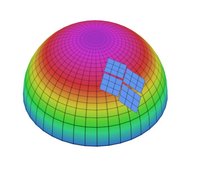Hi,
I've been looking the whole day to solve this problem and I cannot find a solution.
I have the general equation of a sphere:

I have also a function that gives a value for every point in the 3D space: f(x,y,z). This function describes amount of light falling in at a point / m2.
Now I want to know what is the total amount of light on the sphere. So I have to sum the function over the total area of the sphere. I would think this is an integral of the form int(f(x,y,z) * ds1 *ds2) with ds1 and ds2 some perpendicular vectors in the tangent plane to the sphere in the point x,y,z.
How can I calculate this? I believe I should write ds1 and ds2 in function of x and y and then sum somehow.
Much thanks to the people willing to help me.
Matthias
I've been looking the whole day to solve this problem and I cannot find a solution.
I have the general equation of a sphere:

I have also a function that gives a value for every point in the 3D space: f(x,y,z). This function describes amount of light falling in at a point / m2.
Now I want to know what is the total amount of light on the sphere. So I have to sum the function over the total area of the sphere. I would think this is an integral of the form int(f(x,y,z) * ds1 *ds2) with ds1 and ds2 some perpendicular vectors in the tangent plane to the sphere in the point x,y,z.
How can I calculate this? I believe I should write ds1 and ds2 in function of x and y and then sum somehow.
Much thanks to the people willing to help me.
Matthias

